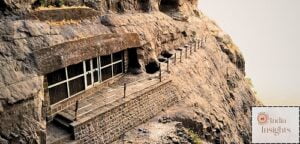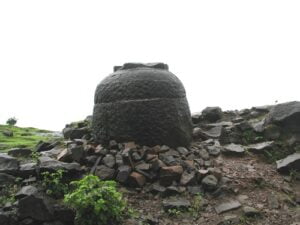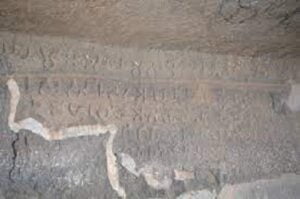In the history of ancient India, the Satavahana lineage held one of the largest kingdoms. Besides various notable Emperors, the kingdom was also ruled by Empress Naganika, also known as Nayanika. The Naneghat or Nanaghat Inscription introduces us to this great female personality and provides insights into the dynasty. Probably, she was the first woman to have her face on Indian coins.
In the word ‘Naneghat’, the name Nane means ‘coin’, and Ghat means ‘pass’. The name was derived from its function. Naneghat or Nanaghat is a path that was used as a tollbooth to collect tolls from traders crossing the hills. The walls of this place recorded a lot about the remarkable Satavahana Empire.
Location of Nanaghat Inscription:

The inscriptions are on the back of the wall of the Nanaghat cave. There are a series of inscriptions engraved on the cave wall which is one of the trade routes during the reign of Satavahana Dynasty. The cave is reachable by road via highways 60 or 61. This site is 120 km to the north of Pune and 165 km to the east of Mumbai. Moreover, the closest station to reach this place is Kalyan station. Besides the cave, there are more historical places nearby like the Lenyadri Group of Theravada Buddhist Caves.
History and Brief Description:

During the reign of the Satavahana Dynasty, Nanaghat Pass was one of the trade routes. It connected the Konkan coast communities with the Deccan plateau through Junnar. This cave was discovered by Willam Sykes while hiking. Firstly, he presumed that it was a Buddhist cave. Later he visited the site several times and made an eye-copy of the script engraved on the left and right wall of the cave.
The inscriptions on the cave wall are attributed to a queen of Satavahana dynasty. However, the name of the queen is not clear. Most probably the name is either Nayanika or Naganika. She is likely the wife of Satavahana king Satakarni.
There is a lot of uncertainty about the date of the inscriptions. However, most scholars believe the nanaghat inscription is from the early 1st century BCE. Some scholars also place them in the 2nd century BCE.
The nanaghat inscription holds an important role in establishing the history of the Satavahana dynasty. Mentions of Vedic gods like Dharma, Indra, Surya, Chandra, etc. are there.
People Also Read:The Remarkable Satavahana Dynasty: A Glimpse into the Past
Facts Mentioned in Nanaghat Inscription:

There are two long inscriptions on the left and right walls of the nanaghat cave. Besides those long inscriptions, there is also a small inscription on the top above the eight life-sized missing statues. Moreover, the engravings of this inscription are in Brahmi Script and the language is Prakrit.
Left wall:
On the left wall, the inscription opens with expressing adoration to various Vedic gods like Dharma, Indra, Samkarshana, and Vasudeva, who descended from the moon and possess majesty. It also acknowledges Yama, Varuna, Kubera, and Vasava, as the four guardians of the world. Besides, the inscription marks Prince Vedisri as “the best of royal princes”.
Referring to “the Lord of Dekhan” (Deccan), the inscription praises a courageous hero who governs without opposition. According to the legends, this line was written dedicated to the Satavahana ruler Satakarni I.
In the next few lines, it praises the heroic qualities of the Maharathi, the increaser of the Amgiya race.
The nanaghat inscription records a lot about the Satavahana Empress Naganika or Nayanika. She was the wife of King Satakarni I and was born into the Amgiya family. The inscription shows respect for her, mentioning her as the nurturing mother of Yedisri and Sakti. Besides, it highlights her role in giving blessings and abundance.
From this written evidence, we come to know that this Empress (Naganika) was well-versed in rituals, vows, and offerings. From here, the remaining part of the inscription tells about various sacrifices and generous offerings by the Satavahans. Such sacrifices include
i) an Agnyadheya sacrifice with the offering of 12 cows and 1 horse.
ii) An Anvarambhaniya sacrifice with an offering of milch cows.
iii) A Rika sacrifice with offerings of 11,000 cows and 1000 horses.
iv) Suya sacrifice, and many more.
Apart from these, the inscription also mentions a dedication of an excellent village, with an offering of 24,400 Karshapanas. Additionally, gifts to the spectators and helpers amounted to 6,001 Karshapanas (coins).

Right Wall:
The surviving inscription of the right wall tells about the various ceremonies and sacrifices. During these rituals, grain, dresses, horses, chariots, cows, gold, and other valuable items are given as offerings. Some mentioned sacrifices are
i) A second horse sacrifice with offerings of a horse with silver trappings, 12 golden items, and another gift of 14,000 Karshapanas, along with a village and an elephant.
ii) An Ovaya sacrifice with an offering of 17 milch cows.
iii) A Bhagala-Dasharatha sacrifice with offerings of 10,001 cows.
iv) Gargatriratra sacrifice, where 301 dresses were given as gifts to the spectators and helpers.
v) A Gavamayana sacrifice with offerings of 1,101 cows.
vi) Angirasamayana sacrifice.
vii) Satatirata sacrifice.
vii) chhandomapavamanatriratra sacrifice.
Inscriptions above the missing sculptures:
The inscriptions above the 8 missing sculptures most probably hold the name of those statues. These are –
Raya Simuka- Satavahano sirimato.
Devi – Nayanikaya rano cha.
Siri-Satakanino.
Kumaro Bhaya.
[unclear]
Maharathi Tranakayiro.
Kumaro Hakusiri.
Kumaro Satavahano.
You Can Also Read Our Other Inscriptions Related Posts.
Significance of Nanaghat Inscription:
According to Georg Buhler, this inscription belongs to the oldest historical documents of Western India. He also said that in some respect these inscriptions are more interesting and important than all other cave inscriptions taken together.
There are mentions of Lord Balaram, and Vasudeva Krishna, along with the other gods like Indra, Surya, Chandra, Yama, Varuna, and Krbera. This is important in establishing the link between Vedic tradition to Hinduism. This inscription is a reliable source of the Satavahana Dynasty.
The Nanaghat Inscription plays a very important role in studying of history of numerals. Despite damages, there are at least 30 mentions of numerals in the inscription. This represents the world’s oldest known numeration symbol that resembles the modern era.
This inscription is also evidence that the royal families continued to perform Vedic srauta sacrifices through at least the 1st century BCE. There is proof that secular life-size murti (idols) were already popular by then.
The Naneghat, also known as Nanaghat Inscription, introduces us to this great female personality and provides insights into the dynasty. Though Queen Naganika was the main focus, it mentions other rulers also. The inscription will give you a wide idea about the Satavahanas, including their culture, religious practices, and many more.
Thus, undoubtedly, the Nanaghat inscription is one of the important sources of information about the great Satavahana dynasty.

